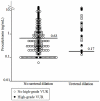Prediction of high-grade vesicoureteral reflux after pediatric urinary tract infection: external validation study of procalcitonin-based decision rule
- PMID: 22216314
- PMCID: PMC3247275
- DOI: 10.1371/journal.pone.0029556
Prediction of high-grade vesicoureteral reflux after pediatric urinary tract infection: external validation study of procalcitonin-based decision rule
Erratum in
- PLoS One. 2012 Feb 21;78(8). doi: 10.1371/annotation/c23484a1-f516-4391-a23b-3db456be8edf
Abstract
Background: Predicting vesico-ureteral reflux (VUR) ≥3 at the time of the first urinary tract infection (UTI) would make it possible to restrict cystography to high-risk children. We previously derived the following clinical decision rule for that purpose: cystography should be performed in cases with ureteral dilation and a serum procalcitonin level ≥0.17 ng/mL, or without ureteral dilatation when the serum procalcitonin level ≥0.63 ng/mL. The rule yielded a 86% sensitivity with a 46% specificity. We aimed to test its reproducibility.
Study design: A secondary analysis of prospective series of children with a first UTI. The rule was applied, and predictive ability was calculated.
Results: The study included 413 patients (157 boys, VUR ≥3 in 11%) from eight centers in five countries. The rule offered a 46% specificity (95% CI, 41-52), not different from the one in the derivation study. However, the sensitivity significantly decreased to 64% (95%CI, 50-76), leading to a difference of 20% (95%CI, 17-36). In all, 16 (34%) patients among the 47 with VUR ≥3 were misdiagnosed by the rule. This lack of reproducibility might result primarily from a difference between derivation and validation populations regarding inflammatory parameters (CRP, PCT); the validation set samples may have been collected earlier than for the derivation one.
Conclusions: The rule built to predict VUR ≥3 had a stable specificity (ie. 46%), but a decreased sensitivity (ie. 64%) because of the time variability of PCT measurement. Some refinement may be warranted.
© 2011 Leroy et al.
Conflict of interest statement
Figures



Similar articles
-
Usefulness of serum procalcitonin level for prediction of vesicoureteral reflux in pediatric urinary tract infection.Iran J Kidney Dis. 2014 Jan;8(1):37-41. Iran J Kidney Dis. 2014. PMID: 24413719
-
Prediction of moderate and high grade vesicoureteral reflux after a first febrile urinary tract infection in children: construction and internal validation of a clinical decision rule.J Urol. 2012 Jan;187(1):265-71. doi: 10.1016/j.juro.2011.09.034. Epub 2011 Nov 17. J Urol. 2012. PMID: 22100009
-
Role of procalcitonin in predicting dilating vesicoureteral reflux in young children hospitalized with a first febrile urinary tract infection.Pediatr Infect Dis J. 2013 Sep;32(9):e348-54. doi: 10.1097/INF.0b013e3182905d83. Pediatr Infect Dis J. 2013. PMID: 23584577
-
Procalcitonin is a predictor for high-grade vesicoureteral reflux in children: meta-analysis of individual patient data.J Pediatr. 2011 Oct;159(4):644-51.e4. doi: 10.1016/j.jpeds.2011.03.008. Epub 2011 Apr 20. J Pediatr. 2011. PMID: 21511275 Review.
-
[Procalcitonin and prediction of vesico-ureteral reflux in pediatric urinary tract infection].Bull Acad Natl Med. 2007 Nov;191(8):1731-43; discussion 1743-4. Bull Acad Natl Med. 2007. PMID: 18666470 Review. French.
Cited by
-
Antibiotic prophylaxis and reflux: critical review and assessment.F1000Prime Rep. 2014 Nov 4;6:104. doi: 10.12703/P6-104. eCollection 2014. F1000Prime Rep. 2014. PMID: 25580258 Free PMC article. Review.
-
Cases of Pediatric Pyelonephritis: A Single-Center Retrospective Study from an Extended-Spectrum β-Lactamase-Producing Escherichia coli Endemic Area in Japan.Yonago Acta Med. 2023 Feb 13;66(1):104-111. doi: 10.33160/yam.2023.02.013. eCollection 2023 Feb. Yonago Acta Med. 2023. PMID: 36820299 Free PMC article.
-
Imaging studies and biomarkers to detect clinically meaningful vesicoureteral reflux.Investig Clin Urol. 2017 Jun;58(Suppl 1):S23-S31. doi: 10.4111/icu.2017.58.S1.S23. Epub 2017 May 24. Investig Clin Urol. 2017. PMID: 28612057 Free PMC article. Review.
-
Can procalcitonin reduce unnecessary voiding cystoureterography in children with first febrile urinary tract infection?Iran J Pediatr. 2014 Aug;24(4):418-22. Epub 2014 Jul 19. Iran J Pediatr. 2014. PMID: 25755864 Free PMC article.
References
-
- American Academy of Pediatrics. Committee on Quality Improvement. Subcommittee on Urinary Tract Infection. Practice parameter: the diagnosis, treatment, and evaluation of the initial urinary tract infection in febrile infants and young children. Pediatrics. 1999;103:843–852. - PubMed
-
- Williams G, Fletcher JT, Alexander SI, Craig JC. Vesicoureteral reflux. J Am Soc Nephrol. 2008;19:847–862. - PubMed
-
- Guignard JP. Urinary infection after micturating cystography. Lancet. 1979;1:103. - PubMed
-
- Garin EH, Olavarria F, Garcia Nieto V, Valenciano B, Campos A, et al. Clinical significance of primary vesicoureteral reflux and urinary antibiotic prophylaxis after acute pyelonephritis: a multicenter, randomized, controlled study. Pediatrics. 2006;117:626–632. - PubMed
Publication types
MeSH terms
Substances
LinkOut - more resources
Full Text Sources
Other Literature Sources
Medical
Research Materials
Miscellaneous

